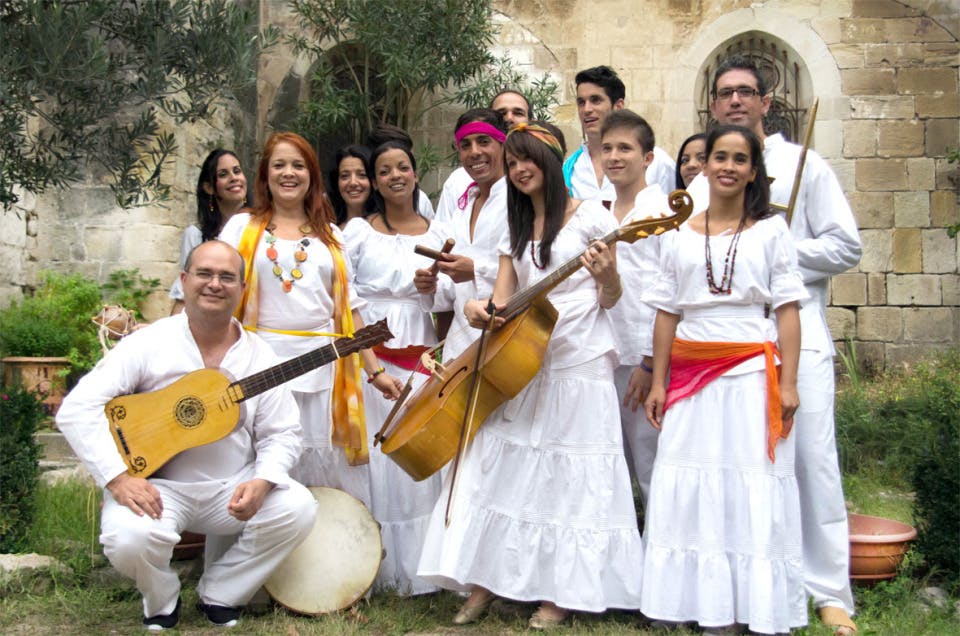Cuban early-music group Ars Longa makes a lively New York debut

Ars Longa performed Sunday afternoon at Corpus Christi Church in the Music Before 1800 series.
The event was a kind of simulation — a musical recreation of a Renaissance-era religious festival — but the energy was real: The Cuban classical ensemble Ars Longa, made its New York City debut, turning Corpus Christi Church in Manhattan into a veritable block party Sunday afternoon, with musicians and spectators mingling in the chapel’s balconies and aisles.
Fusing Western classical with song styles drawn from Africa, Ars Longa performed music that grew out of the contacts between European powers and African populations they colonized beginning in the late 15th Century. As the program notes pointed out, this “integration of African culture into the Spanish and Portuguese society” arose from enslavement and exploitation, and resulted in a European portrayal of African life and customs with “a somewhat patronizing slant.”
But “Resonancias de Africa en el Nuevo Mundo,” (“African Resonances in the New World”) presented by New York’s long-running series Music Before 1800—in cooperation with Gotham Early Music Scene and Americas Society–made the case that the resulting music was, on balance, more celebratory and humanizing than objectifying or cruel.
Ars Longa — discovery, study and performance of colonial music — also brought these cross-pollenated songs and poems to life on Sunday as more than just relics of scholarship.
The model was the liturgical feast — great gatherings produced around religious holidays in churches of Spain and Portugal. Their musical centerpieces were the villancicos — songs of praise, worship and everyday life combining European melody, harmony and language with Africanized vernacular, rhythm and verse-chorus-verse storytelling.
The six singers and ten instrumentalists of Ars Longa were skillful and often playful advocates for this convergence of royal court, chapel and street. They delivered classical voicings with colloquial style, and employed dancing or simple props to help depict an occasion of religious fervor mixed with revelry and good humor.
No single piece captured the spirit better than Antonia, Flaciquiya, Gacipá, an epic in miniature about the hazards of perhaps over-celebrating the birth of Jesus. From guitarist Alánd Lopez’s introductory strumming, Antonia blossomed into a polyphonic ode. Sopranos, tenors and a baritone alternated between praise of the savior and exclamations of “Mucho me duele la cabeza” — “I have a terrible headache.”
Jesús Javier Soriano played to the mood with a woozy trombone line that ended with him being mock-escorted away by his fellow musicians, like an overextended worshipper in need of a nap.
There were more restrained examples of the form. The program opener, Como tienen los morenos (“Since the blacks possess”), was reminiscent of Bach and Vivaldi in its tuneful elegance, but still true to the conversational feel of the villancico — male-female dialogue about the festivities and the euphoric sense of communion they create.
Se cuchamo, Magri Antona (“We hear, Sister Antona”) was essentially a motet, a church choir piece using three lines sung percussively and enlarged through repetition. Ars Longa employed great variations in voices and vocal colorings to achieve an impressive largeness of sound on Se cuchamo and the finale, Sá aquí turo zente pleta (“Here are only black people”).
Sá aquí was also Ars Longa at its most interactive. Female musicians plucked male audience members from the church pews and danced them toward the front of the chapel, where they joined an exuberant group refrain that moved one audience member — still in the seats — to a spontaneous cry of “Viva Cuba!”
The program lasted a little over an hour but covered a wealth of sung, played and spoken material, most of it written in the 17th and 18th centuries and much of it culled from church archives in central America. The concert could have run considerably longer with prefatory remarks, but Ars Longa and its founding director, soprano Teresa Paz, let the performance explain itself.
If anyone served the role of narrator, it was countertenor Yunié Gainza, delivering spoken verses in an elegant high timbre that he sometimes turned to comic effect, playing a combination of preacher, poet and emcee, and embodying the idea that culture and personality can thrive even in a climate of dominion.


